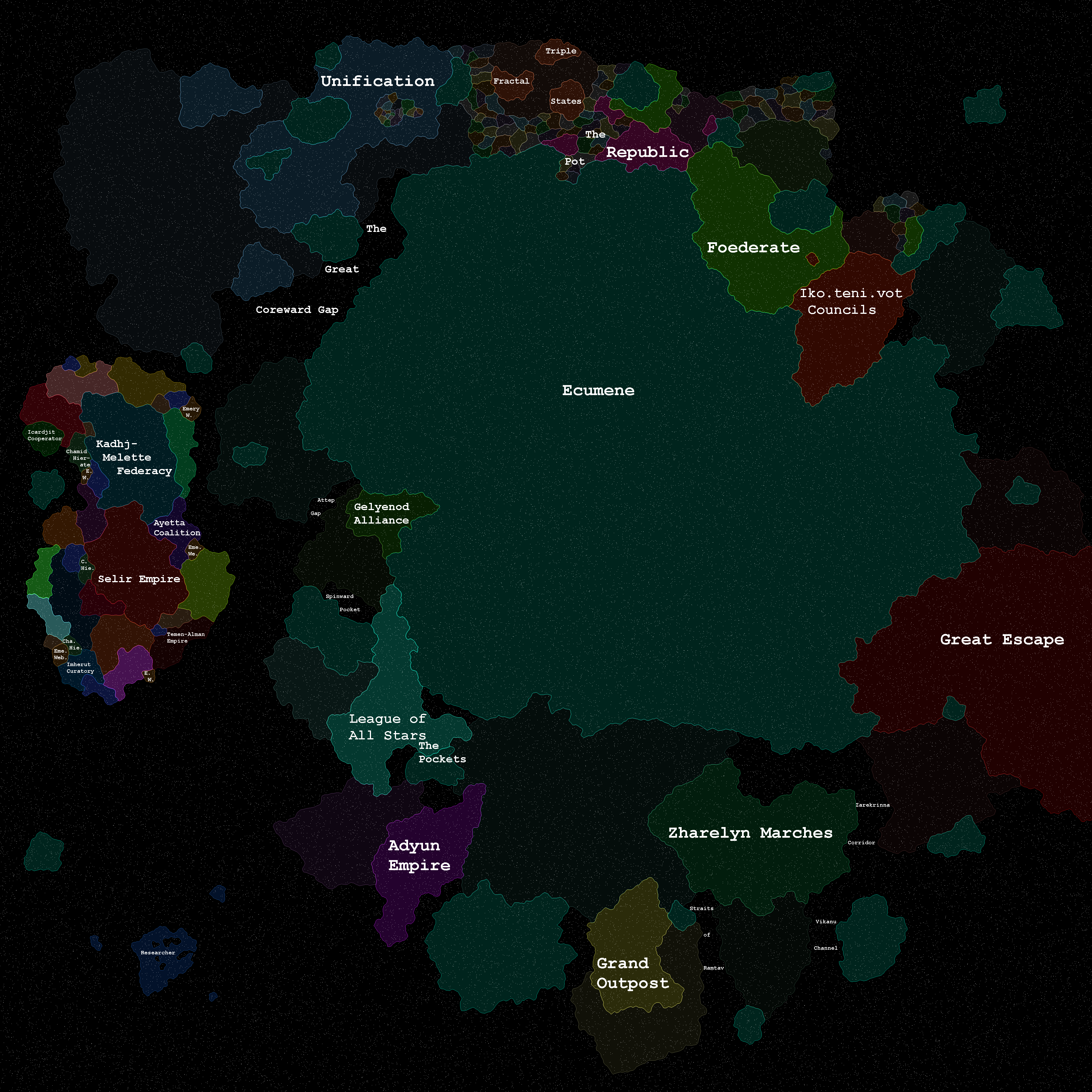A map of the whole of the Ecumene, plus its neighbors.

Many of the borders of the Ecumene have been roughly stable for hundreds of years, with some even lasting millenia. Whether by way of treaty (whether with a single nation or in sequence), by informal agreement, or merely by the whims of time; these borders (though always extremely loose with regards to entry) together define a characteristic half-jagged half-rounded shape for the Ecumene. Despite their seeming stability, however, even the longest-lasting (two to three millenia) vary wildly on the small scale- in the span of months, systems may go from being part of the Ecumene to being part of another star-state to being part of the Ecumene once more. The Ecumene also expands at extremely varied rates- this is difficult to predict, and often only works in hindsight, but in recent times the rate varies between -6 and 9 light-years per decade at the extremes.
These moves are often scheduled and small, with spontaneous secessions or gains of dozens of stars being so rare as to only happen a few times per decade, but this still means that no map of the Ecumene can possibly be completely up-to-date. The longest journey at the fastest speed possible within the Ecumene still takes over a year, and ansible speeds lag behind that by a factor of three- so even a mapping outfit with nigh-infinite resources would need to develop a faster form of FTL to get accurate information for every last system. As such, most resign themselves to either being more out of date the further the mapmaker is from the rest of the Ecumene or to having smaller regional maps (even the largest contiguous sectors take only a couple months to traverse). This map takes the former path, but the current situation is much better than in the past- though the Ecumene was thousands of light-years smaller, travel times were much longer.
One of the more minor major questions in the field of xenohistoriosociology is: How big do interstellar polities usually get? In the Ecumene, the first remnants of a large interstellar polity (the Zé Bilur Codependencies, a million-year-old grouping of three hundred stars lost in between blooms) were unearthed in the early 1900s- and study began apace from there. After millenia of looking around, finding ancient databases, and asking others; varied answeres have been found. The overall average size for a polity in the Localmost Starway is, of course, very nearly one planet. This number includes non-starfaring civilizations, so a more useful figure is that if an interstellar polity encompasses more than a hundred systems it is most likely to reach a maximum around two hundred systems. Generally, as polities reach ever-rarer large sizes they are most likely to stop around ten times, a hundred times, or even a thousand times that. Past twenty thousand systems, it is extremely rare for an even remotely unified polity to exist rather than a nebulous civilization- and no civilization has reached the lofty figure of a billion stars, not even those civilizations visible only by galactic array telescope.
As the third-largest and second-oldest polity within easy reach of the center of the Ecumene, the Unification is notable for being impenetrably confusing. This is largely due to their near-universal adoption of the practice pretending to be a member of a groupmind: nearly every place in the Unification follows this aesthetic in some way. The actual details of the aesthetic vary- though cybernetic, chitinous, and creepy-but-otherwise-normal are the most common styles. Whether people in the Unification are part of a groupmind is much more varied than one might expect- though both a complete lack of one and a ubiquity of one are both uncommon extremes. Cultural code-switching and incomprehensible rituals (and symbols) are extremely highly prized.
←International First-Level Divisions [UNAVAILABLE] International Map Basic→
Return to main page.